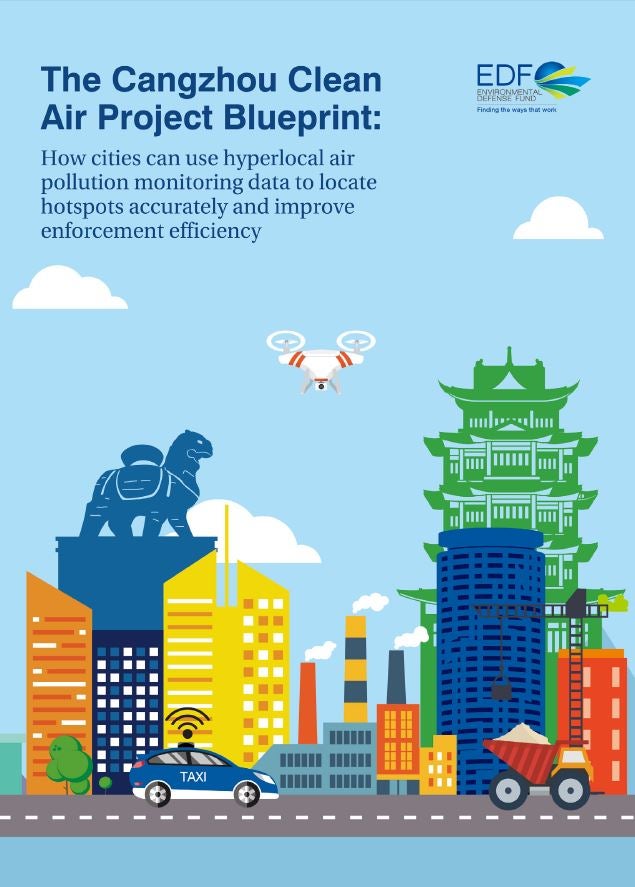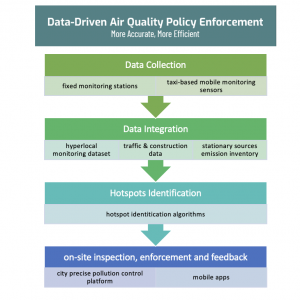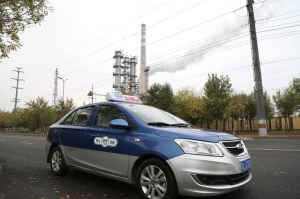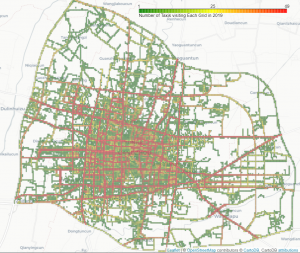Data-Driven Accurate Air Quality Monitoring, Inspection and Enforcement
The Cangzhou Clean Air Pilot Project in China reveals how innovative air quality monitoring (using a fleet of 50 taxis) could pinpoint air pollution hotspots at a finer resolution of hundreds of meters compared to several kilometers’ resolution from national pollution monitors. Using this data, information about hotspot locations was sent via mobile app to pollution enforcement inspectors. Inspectors were dispatched to the locations to determine the source of pollution for further investigation or enforcement. The project demonstrates the potential of hyperlocal air quality monitoring tools in supporting targeted air quality enforcement, serving as a model to help other cities in China and around the world in reducing air pollution. The 2019 project was a joint effort between EDF’s Beijing Representative Office and the Beijing Huanding Environmental Big Data Institute in Cangzhou City.
Data to action

Organizing air quality monitoring and initiating enforcement activities with the city and local level environmental authorities play a key role in improving China’s air quality. However, existing air quality monitoring networks and enforcement systems are still far from being effective and efficient.
The Cangzhou pilot project, organized by Environmental Defense Fund China, Cangzhou City government, HD Environmental Consortium, and SUSTC Engineering Technology Innovation Centre (Beijing), aims to demonstrate how monitoring technologies can deliver hyperlocal data to advise environmental officers to locate air pollution hotspots accurately and improve enforcement efficiency, explore a data-driven solution to improve air quality. The Cangzhou Clean Air Project Blueprint provides lessons learned from the two-year pilot, illuminating how mobile monitoring can be combined with existing monitoring networks to identify hotspots.
(The workflow is shown below.)

In October 2018, we began our fieldwork and tested multiple technologies, including low-cost sensors carried by drones, private and commercial vehicles, specially modified vehicles with on board LIDAR, as well as mobile source-apportionment instruments.
• Data collection.
To increase the spatiotemporal coverage of Cangzhou’s existing air quality monitoring network (consisting of three monitors), an additional 320 lower-cost stationary sensors were deployed by the city in densely populated areas and around key emission sources.

In addition, a 50-taxi fleet equipped with low-cost sensors was deployed. The mobile monitoring network can cover an average of almost 5,000 miles of road each day in the city center area of Cangzhou.
• Data integration.
Integration of both fixed and mobile monitoring data serves as the basis to perform hotspot identification. We divided the city center area of Cangzhou into 100m x 100m grids. The mobile monitoring dataset is aggregated into the 100m grids, at this stage, we only take into account the grids with at least 8 hours per day to report daily hotspots to ensure the mobile measurements can reflect the diurnal concentration changes. The fixed monitoring stations are also assigned to the corresponding grids. The daily mean concentration for each grid is calculated by first taking the means of stationary and mobile monitoring data in the same hour, and then calculate the mean of all hourly data in the given day. With the integrated dataset, we can identify hotspots (100m by 100m) in the next phase.

Map of roads (by 100-meter grid) monitored by taxis in Cangzhou City. 2019
• Hotspot identification
We’ve developed a set of algorithms to identify hotspots (locations with elevated PM2.5 concentrations, relative to the three regulatory monitors). The hotspots features higher than surrounding areas, or above a certain threshold or exceptional values of the PM2.5 concentration.
• On-site inspection, enforcement and feedback.
The hotspots identified were sent to city environmental enforcement officers. Enforcement officers followed the inspection advice to perform the on-site inspection for each hotspot identified and take actions to correct the violation behaviors, and provide feedback about their findings.
To improve the enforcement efficiency, a mobile application was developed. The Cangzhou pollution control platform automatically sends hotspot information to officers and obtains feedback after inspection.

